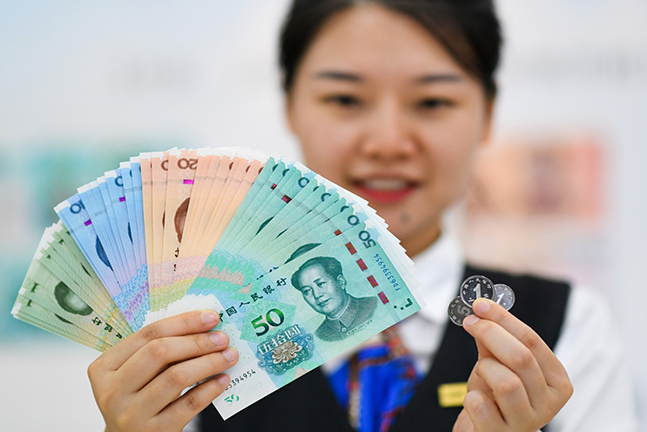
A woman shows banknotes and coins included in the 2019 edition of the fifth series of the renminbi. [Photo/Xinhua]
The renminbi is becoming increasingly popular as an international negotiable instrument, a medium of exchange to settle global transactions, with its proportion in international payments rising to 3.2 percent in January, breaking the record set in 2015. And the currency tends to serve as a safe haven because of the recent heightened market volatility.
The renminbi ranked only 35th when SWIFT began tracking global payment data in October 2010. Now, it ranks fourth. This means the Chinese currency’s internationalization process has gained pace in recent times.
What are the factors behind the renminbi’s rising popularity as a global medium of exchange?
First, the international community today has greater confidence in China’s economy, because of the country’s sound economic fundamentals and steady growth. In 2021, China achieved a GDP growth of 8.1 percent year-on-year-higher not only than the 8 percent forecast by global financial institutions and ratings agencies but also the 6 percent target set by the Chinese government at the beginning of last year.
The strength of the Chinese economy is reflected in the country’s GDP of 114 trillion yuan ($18 trillion), the second-highest in the world and accounting for more than 18 percent of the global economy.
The strong performance of the Chinese economy, along with its rising share in the global economy and trade, has prompted many central banks and international investors to acquire renminbi assets in large amounts. In January alone, the amount of major Chinese bonds held by central banks across the world and global investors increased by more than 50 billion yuan. For many of these central banks and investors, quality Chinese bonds remain the first choice of investment.
And by the end of January, total foreign renminbi holdings exceeded 2.5 trillion yuan.
Second, renminbi assets have become a “safe haven” for a large number of financial institutions and foreign investors. The Chinese currency has also been playing the role of a “stabilizer” in the global economy. No wonder the renminbi’s exchange rate showed a strong rising trend in 2021, with its exchange rate against the US dollar appreciating by 2.3 percent.
In addition, since the Chinese government is expected to launch a relatively loose monetary policy this year, China’s foreign exchange reserves are likely to increase steadily. This, too, has boosted the confidence of central banks and international investors in the renminbi.
Moreover, with the International Monetary Fund set to review the composition and valuation of the Special Drawing Rights basket in July, the proportion of the renminbi is expected to increase in the IMF’s currency mix, partly because of the strong and growing renminbi-denominated trade and China’s increasing share in global trade.
These factors have not only enhanced the status of the renminbi as a global reserve currency but also prompted many international investors and financial institutions to increase their assets in the Chinese currency.
As the process of the renminbi’s internationalization gathers pace, international markets, including financial institutions and investment banks, are showing greater confidence in the Chinese economy and currency. And with the steady growth of China’s economy, the global demand for the renminbi as a medium of exchange, as well as reserves, will continue to increase.
The Hong Kong Special Administrative Region, the world’s largest offshore renminbi trading center, handles about 76 percent of the world’s offshore renminbi settlement business. And the SAR is expected to play a more active role in the renminbi’s internationalization process in the future.
Post time: Mar-12-2022

